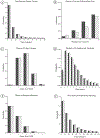Forecasting emergency department crowding: a discrete event simulation
- PMID: 18387699
- PMCID: PMC7252622
- DOI: 10.1016/j.annemergmed.2007.12.011
Forecasting emergency department crowding: a discrete event simulation
Abstract
Study objective: To develop a discrete event simulation of emergency department (ED) patient flow for the purpose of forecasting near-future operating conditions and to validate the forecasts with several measures of ED crowding.
Methods: We developed a discrete event simulation of patient flow with evidence from the literature. Development was purely theoretical, whereas validation involved patient data from an academic ED. The model inputs and outputs, respectively, are 6-variable descriptions of every present and future patient in the ED. We validated the model by using a sliding-window design, ensuring separation of fitting and validation data in time series. We sampled consecutive 10-minute observations during 2006 (n=52,560). The outcome measures--all forecast 2, 4, 6, and 8 hours into the future from each observation--were the waiting count, waiting time, occupancy level, length of stay, boarding count, boarding time, and ambulance diversion. Forecasting performance was assessed with Pearson's correlation, residual summary statistics, and area under the receiver operating characteristic curve.
Results: The correlations between crowding forecasts and actual outcomes started high and decreased gradually up to 8 hours into the future (lowest Pearson's r for waiting count=0.56; waiting time=0.49; occupancy level=0.78; length of stay=0.86; boarding count=0.79; boarding time=0.80). The residual means were unbiased for all outcomes except the boarding time. The discriminatory power for ambulance diversion remained consistently high up to 8 hours into the future (lowest area under the receiver operating characteristic curve=0.86).
Conclusion: By modeling patient flow, rather than operational summary variables, our simulation forecasts several measures of near-future ED crowding, with various degrees of good performance.
Figures





Similar articles
-
Forecasting emergency department crowding: a prospective, real-time evaluation.J Am Med Inform Assoc. 2009 May-Jun;16(3):338-45. doi: 10.1197/jamia.M2772. Epub 2009 Mar 4. J Am Med Inform Assoc. 2009. PMID: 19261948 Free PMC article.
-
Forecasting emergency department crowding: an external, multicenter evaluation.Ann Emerg Med. 2009 Oct;54(4):514-522.e19. doi: 10.1016/j.annemergmed.2009.06.006. Epub 2009 Aug 29. Ann Emerg Med. 2009. PMID: 19716629 Free PMC article.
-
Measuring and forecasting emergency department crowding in real time.Ann Emerg Med. 2007 Jun;49(6):747-55. doi: 10.1016/j.annemergmed.2007.01.017. Epub 2007 Mar 27. Ann Emerg Med. 2007. PMID: 17391809 Free PMC article.
-
Comparison of methods for measuring crowding and its effects on length of stay in the emergency department.Acad Emerg Med. 2011 Dec;18(12):1269-77. doi: 10.1111/j.1553-2712.2011.01232.x. Acad Emerg Med. 2011. PMID: 22168190 Review.
-
Improving service quality by understanding emergency department flow: a White Paper and position statement prepared for the American Academy of Emergency Medicine.J Emerg Med. 2010 Jan;38(1):70-9. doi: 10.1016/j.jemermed.2008.03.038. Epub 2008 Jun 2. J Emerg Med. 2010. PMID: 18514465 Review.
Cited by
-
ED crowding and the use of nontraditional beds.Am J Emerg Med. 2012 Oct;30(8):1474-80. doi: 10.1016/j.ajem.2011.12.007. Epub 2012 Mar 3. Am J Emerg Med. 2012. PMID: 22386355 Free PMC article.
-
Decreased length of stay after addition of healthcare provider in emergency department triage: a comparison between computer-simulated and real-world interventions.Emerg Med J. 2013 Feb;30(2):134-8. doi: 10.1136/emermed-2012-201113. Epub 2012 Mar 7. Emerg Med J. 2013. PMID: 22398851 Free PMC article.
-
An overview of health forecasting.Environ Health Prev Med. 2013 Jan;18(1):1-9. doi: 10.1007/s12199-012-0294-6. Epub 2012 Jul 28. Environ Health Prev Med. 2013. PMID: 22949173 Free PMC article. Review.
-
Application of Queuing Analytic Theory to Decrease Waiting Times in Emergency Department: Does it Make Sense?Arch Trauma Res. 2013 Dec;2(3):136-7. doi: 10.5812/atr.11376. Epub 2013 Dec 1. Arch Trauma Res. 2013. PMID: 24693525 Free PMC article. No abstract available.
-
A system analysis of a suboptimal surgical experience.Patient Saf Surg. 2009 Jan 6;3(1):1. doi: 10.1186/1754-9493-3-1. Patient Saf Surg. 2009. PMID: 19126219 Free PMC article.
References
-
- Committee on the Future of Emergency Care in the United States Health System. Hospital-based Emergency Care: At the Breaking Point. Washington, DC: National Academies Press; 2006.
-
- Kellermann AL. Crisis in the emergency department. N Engl J Med. 2006;355:1300–1303. - PubMed
-
- Miro O, Antonio MT, Jimenez S, et al. Decreased health care quality associated with emergency department overcrowding. Eur J Emerg Med. 1999;6:105–107. - PubMed
-
- Begley CE, Chang Y, Wood RC, et al. Emergency department diversion and trauma mortality: evidence from Houston, Texas. J Trauma. 2004;57):1260–1265. - PubMed
-
- Hwang U, Richardson LD, Sonuyi TO, et al. The effect of emergency department crowding on the management of pain in older adults with hip fracture. J Am Geriatr Soc. 2006;54:270–275. - PubMed
Publication types
MeSH terms
Grants and funding
LinkOut - more resources
Full Text Sources
Other Literature Sources

